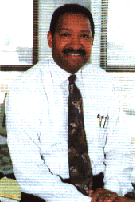

Vision 2000, a strategic plan for ensuring that LBL maintains its position as one of the nation's premier scientific institutions, calls for the Laboratory to eliminate organizational redundancy and fragmentation. This past year, LBL for the first time in its history brought the functions of operations and administration under the management of a single senior executive. With the approval of the UC Board of Regents, Klaus Berkner, a 30-year veteran of LBL, was appointed the new Deputy Director for Operations. This consolidation of administration and operations is the first major reorganization of the Laboratory since 1991. Berkner serves on DOE's Basic Energy Sciences Advisory Committee.


Klaus Berkner (left) and Walter Blount Jr.
This past year saw the implementation of a revised employee orientation program, designed to better welcome and inform new arrivals and make them feel they are part of the LBL community. The program includes guidelines for supervisors to help them support new employees, an orientation session with a guided tour of the Laboratory, and a complimentary lunch at the cafeteria, where new employees can meet and talk with LBL senior managers.
For the first time the Laboratory joined other employers throughout the United States in sponsoring "Take Our Daughters to Work Day." More than 200 girls (and even some boys) participated in this event, the first educational activity of LBL's Center for Science and Engineering Education designed for children of LBL employees. The young guests spent the day participating in a range of activities that included holding transgenic mice, donning fire-fighting outfits, witnessing the power of a PET scanner's electromagnetic field, and making a geological inspection of LBL's famous Hill.
Take Our Daughters to Work Day was just one of several new activities initiated this past year to reach out to the community. Throughout the year more than 150 volunteers from LBL contributed their time in local schools, and more than 30 high school students from local schools came to LBL on internships during the summer.

LBL Deputy Director Pier Oddone (second from left) and Berkeley City Manager Weldon Rucker shake hands after signing a mutual aid pact for Berkeley and LBL firefighters.
This past year also saw the signing of a formal agreement between LBL and the city of Berkeley that authorizes, in the case of a fire, the fire department closest to the emergency to send the first crew. Prior to this mutual-aid pact, legal restrictions limited LBL fire fighters to responding primarily to on-site fires unless specifically requested by a Berkeley fire chief. With five on-duty fire fighters and two engines, the LBL fire department is a valuable resource for our neighbors.

Return to the Table of Contents of the 1994 Regents Report
